Mazda Model R on Mitusbishi Wideblock
I'm not sure who the first person was to actually try this. I know that knowlege of the 2.6L G54B block being in the Mazda trucks has been documented for some time. We took this idea and with the help of forum members, verified the theory by comparing Mazda service manual drawings of several transmissions. We really weren't sure if there would be any suprises, but I just had to answer the question for good. After two incorrect bellhousings, I finally found a salvage company with the correct part. This page lists the info that I have gathered on using a Mazda Model R transmission on a wideblock Mitsubishi engine.
The Mazda Model R transmission is a great option for use with wideblock engines. It has been used in RX7s with over 500hp and can handle revs over 11,000rpm. While it will bolt up to a Mitsubishi block there are several important details to be looked into.
- Choosing the Bellhousing
- Choosing the Transmission
- Clutch & Flywheel
- Chassis Fitment
Choosing the bellhousing
The bellhousing we are using comes from the Mazda B2600. Only 2 years are known to have this specific bellhousing. 1987-88. It is unclear, however, exactly what months are the cut offs for this time range. Many used parts dealers are also very confused about this part. I have even seen an "88" transmission that was a manual, was a wideblock pattern, but was not the detachable bellhousing that we are looking for. Be sure that the bellhousing looks like theThere is also the other 2.6L engine. This is known as the G6 or "MPV" engine. Basically, be sure to get a photo sent to you before you purchase one of these.
Choosing the Transmission
There are several different Model R transmissions.
| 'R' gear ratio's | Car | 1st | 2nd | 3rd | 4th | 5th |
|---|---|---|---|---|---|
| 1988-89 929 | 3.483:1 | 2.015:1 | 1.391:1 | 1:1 | .762:1 |
| 1987-88 TII | 3.483:1 | 2.015:1 | 1.391:1 | 1:1 | .762:1 |
| 1989-91 TII | 3.483:1 | 2.015:1 | 1.391:1 | 1:1 | .719:1 |
| 1993-95 TT | 3.483:1 | 2.015:1 | 1.391:1 | 1:1 | .719:1 |
| 89-93 B2600 | 3.730:1 | 2.158:1 | 1.396:1 | 1:1 | .816:1 |
TT = 3rd Generation "FD" RX7 Twin Turbo
Each one is slightly different than the others. Most of the differences are minor and I have yet to see most of these in person.
- Series 4 have a flat 2 bolt transmission bushing that connect the transmission.
- Series 5 have 2 angled spots and 4 bolts, as well as a differnet crossmember.
- B2600 Transmissions have the shifter mounted 6" forward of that of the RX7 transmissions. This is a very good shifter position for swaps into StarQuests, other wise you need to move the shifter back beyond the stock shifter hole.
- Some B2600 bellhousings use 10 bolts to the gearbox, others use 8. The bolt pattern is the same though and not having those 2 bolts will make little difference.
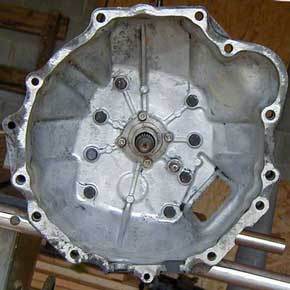
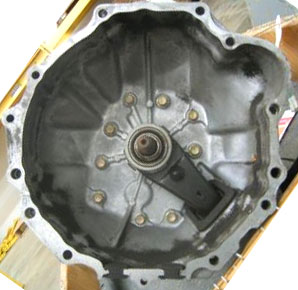
Clutch & Flywheel
There is very little choice when choosing the clutch/flywheel combo. You CANNOT use an RX7 flywheel. The bolt patterns are different between the crank/excentric shaft. This rules out the possibility of using a nice RX7 twin plate clutch as they require you to use their flywheel, which will not bolt to your Mitsubishi Engine. You can obviously use the Mazda B2600 flywheel and Clutch, but there may not be any aftermarket options available that I know of. You cannot use the Eclipse parts either. The flywheels do not have the correct ring gear on the flywheel to use in this wideblock application. Also, the clutch is of a different spline and its only has a 225mm clutch disk surface.
The answer is right in front of our faces! The Starion flywheel and clutch will work! The ring gear is the correct size for the bellhousing, it will bolt to a 6 bolt Mitsubishi block, and the clutch spline matches that of the Model R transmissions. The Starion also has a 240mm clutch disk which can hold more power with less pressure. The main problem with the Starion flywheel is that its so damn heavy. Last time I checked, a Starion flywheel weighs 30lbs+. You can keep this, it wont hurt anything but your horsepower and how fast you can rev through gears (You wont drop revs when you shift though). Luckily there is some aftermarket support for the Starion flywheels. Fidanza makes a 10.5lb flywheel which can be found for under $300 new on Ebay.
After some more research it has been discovered that RX7 Turbo II (240mm) and Later Starion Clutches (240mm) are the same! If you search through ACT's catalog you will see that the pressure plates are the same as are the Disks. The kits are NOT the same though. Starion and RX7 input and throw out bearings are different, which explains this. Even with these differences, its hard to see why clutch companies like ACT charge $50 more in some cases for the exact same part. Why is this important to us? Because we are using the B2600 / RX7 transmission, we need the Mazda throw out bearing anyways. So why not Save $50 and go buy a $6 input bearing instead. That saves you $44 you can spend on other things (like rebuildable u-joints).
One last thing you will need to make is a stone shield for the lower half of the bellhousing. This is a fairly easy part to make. Just take a small piece of aluminum, bend the top 1" 90 degrees and then hold this onto the bellhousing and trace. Trim out your shape. You can hold it on with 2 stock bolts on the block and by through bolting several of the bolts on the lower half of the bellhousing. Dont skip this step or you'll end up with a clutch full of stones and maybe even a damaged flywheel or bellhousing.
Chassis Fitment
There are many things to consider when putting any transmission into a chassis it never belonged in. I will point out the issues when intalling into a Starion, but these poinsts should all be considered when doing any transmission swap.
- Transmission Tunnel Size
- Transmission Crossmember
- Shifter Position
- Transmission Crossmember
- Slave Cylinder
- Driveshaft
- Reverse Lights
- Speedometer
- Gearing
Transmission Tunnel Size
The transmissions itself is pretty slim and the Starion's tunnel will fit it. The problem arises due to the strange tilt between the engine and transmission due to the bellhousing. You can see the amount of tilt in this picture of the transmission in the car:
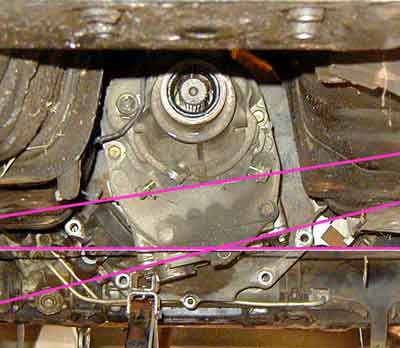
The result of this is that the plugs on the top of the driver side come close to the transmission tunnel. Nothing needs to be modified, but its an important point to remember. Importantly, even with this tilt of the transmission, the shifter still points straight up.
Transmission Crossmember
Due to the differences of the transmission castings for bushings, the actual design of the crossmember may differ between series 4 and 5 transmissions. I had a Series 5 (rumored to be the strongest RX-anything transmission from the factory) so that is what I developed my crossmember to. I first mocked up the crossmember using wood blocks. This helped to eliminate the confusion of the tilt in the transmission while laying underneath the car. I then cut pieces of cardboard to get the angle for the "wings" of the crossmember.
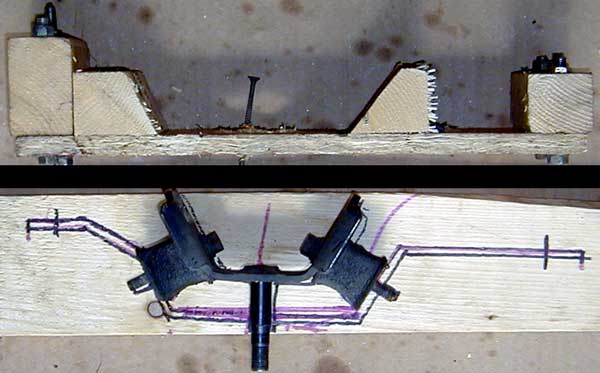
Once these were transfered to a wood prototype I could see all of my critical angles and lengths and take them to be bent from a sheet of steel. I actually used a digital photo of the transmission in the car to find the transmissions "horizontal" compared to the true horizontal of the chassis.
Once this was bent, I drilled and slotted some holes and bolted it all together! I wasnt too sure how strong it would be if it was kept this way so I then had Mr. Bobby cut some shapes (mocked up in cardboard) to use as weld-on reinforcements. The end result is very strong, and retains alot of ground clearance. There are also bushings separating the drivetrain from the chassis to cut down on vibration and noise. Here is a picture of it before it was finished:
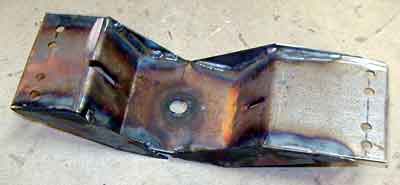
Shifter Position
The length from the block to the shifter is very important. This is what places the shifter where you can use it. This is VERY important as this is one of only 6 control mechanisms in the car. In my car we were moving the driver back as far as possible, almost into the back seat. Since most people wont be doing this, I'll explain how to get near stock shifter location. Using the stock fore/aft engine placement, the RX7 shifter will be located about 6" behind the stock shifter location. Not good if you want to keep your center console. If you can find a full B2600 transmission it will be the best option. It has a different tail housing which places the shifter several inches forward of the RX7's.
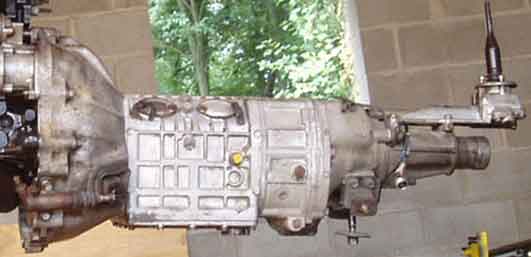
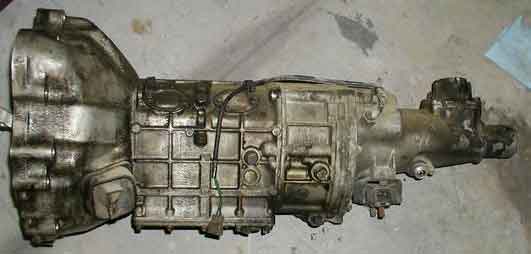
Remember how I had to move my motor foward 2" on the first swap? This was done to give space to the CAS and water neck on the back of the head. Since most people dont want to do major under dash/firewall surgury, the RX7 transmission quickly becomes viable again. The shifter will still sit back farther than stock. For many drivers this is a better location. Trust me, when you're driving hard and you slam that shifter into 3rd, you can REALLY hurt your hand on your radio. You're making a driveshaft anyways (see below) so you might as well move the engine forward and save the hassels of modifying the firewall.
Slave Cylinder
I compared the 3 slave cylinders that were available to me: RX7, B2600 and Starion. I found that only the B2600 unit will work with the B2600 bellhousing. This part may be available on other model cars as well, but I am not sure which. These are arranged top to bottom: RX7, B2600, Starion:
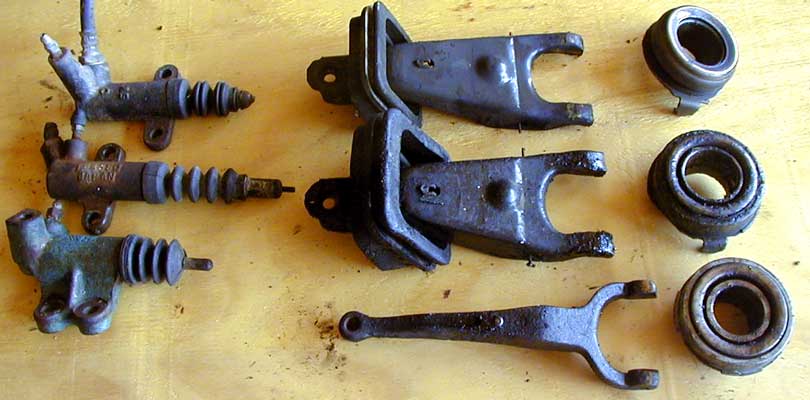
Clutch Fork and Throw-out Bearing
I compared all 3 available to me this time as well. It appears that the RX7 and B2600 use the same clutch fork. Pick one! The Starion has all the proper measurements to use it, but it will need to be drilled to use the B2600 slave cylinder. The RX7 and B2600 throwout bearings are the same and either will work. The Starion one may work as well.
Driveshaft
In most cases, you will need to have a specialized driveshaft shop make the driveshaft for you. Sadly the Model R u-joints are not servicable. You can attempt to press them out and bore out for the larger Starion u-joints. Since the RX7 u-joints are not serviceable (trust me I tried), you will need to use some after market units.
The Spicer part numbers I found were:- RX7 Turbo II transmission yolk: 2603-25 - $69.70
- RX7 Turbo II driveshaft yolk: 2626-31 - $45.25
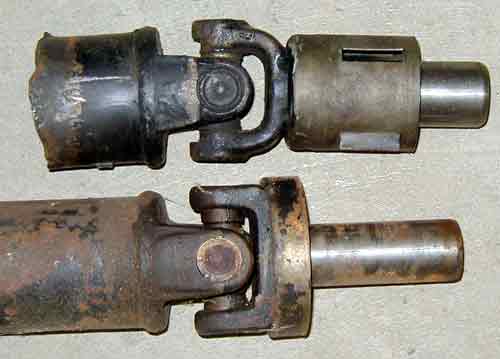
With my motor position, I have measured the drivesahft to be 22.5" long between u-joints. The pipe of the driveshaft is the same size on both the RX7 and Starion, which makes the task much easier.
Reverse Lights
This is just a simple electrical switch. Just wire the 2 wires that went to the stock transmission to this. It is not important if you get the 2 mixed up. Think of it as a loop that is completed when the car is in reverse. The Model R transmission has some other switches too. I'm not sure what they are for sure. Probably neutral safety switches which you may be able to use for no lift shifting with some ECUs. That's for others to figure out. I will be lifting between gears.
Speedometer
Physically, the Starion speedometer cable threads right onto the RX7 transmission. There is likely a way to calculate this. I'll be sure to make a calculator for this if I figure it out. There are different ratio speedometer senders available on several Mazda Models. More info can be found at the bottom of this great site: Solo Miata. Worst case is that you need to Photoshop some new gauge faces to put behind the speedometer so that it reads correctly. This is the least important gauge anyway :-D.
Gearing
The RX7 transmission was geared for rotary engines which have a reputation for having no low end torque on a car with a 4.10:1 rear ratio. While it will be fine (and fuel efficient) to drive on with the Starion's 3.54:1 gears, the car might loose some of its zip. You'll have a 211mph 5th gear (at stock 7500rpm redline) you'll never be able to use.
The Starion has several options, although none of them will be found in a Starion. The years and trim models have not been clearly defined yet. Sites like Car-Part.com can be used to see all of the options and what trim vehicles came with which ratios. You may want to verify tooth counts before purchasing to make sure you get the correct gearset.
| Starion Gearset Options | |
|---|---|
| Vehicle | Gearing |
| Starion (Stock) | 3.54 |
| D50 2WD | 3.90 |
| D50 4WD | 4.22 |
| Montero | 4.62 |
| Montero | 4.88 |
While I haven't made up my mind yet, I did create an MicroSoft Excel spreadsheet that can calculate wheel speeds based on inputs such as engine RPM, transmission gearing, tire diameter, and rear end ratios.
Download the Gear Ratio Tool (22k)
Here is a screen shot from this spreadsheet:
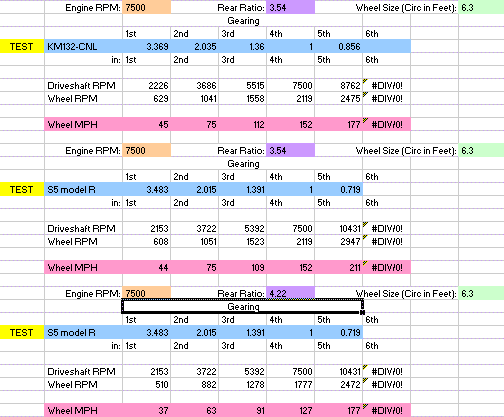
I will try as many of the options as I can to see which performs best with the transmission, course conditions and powerband I will be using.
© 2006 Bowman Cybernetics
